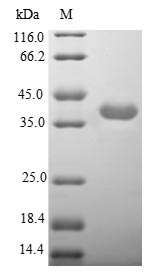Very nice to receive your inquiry. For CSB-EP005389HU1, the expression region we provide is 32-240aa, which is complete extracellular domain (http://www.uniprot.org/uniprot/P32297),
and doesn't include cytoplasmic and transmembrane domains.
The molecular weight which you predicted does not include tag. However, CSB-EP005389HU1 is a fusion protein tagged with N-terminal 10xHis-sumo-tag and C-terminal Myc-tag.
The MW of N-terminal 10xHis-sumo-tag and C-terminal Myc-tag is approximately 20kDa, and the actual size is determined by SDS-PAGE.
Therefore, there is no problem the MW the customer detected is 44kDa. Here we provide the complete sequence (including tag sequence + target protein sequence) for the customer's reference.
MAHHHHHHMSDSEVNQEAKPEVKPEVKPETHINLKVSDGSSEIFFKIKKTTPLRRLMEAFAKRQGKEMDSLRFLYDGIRIQADQTPEDLDMEDNDIIEAHREQIGGGSHHHHHHHHHHLVPRGSRT
+ Target Protein +
AAAEQKLISEEDL






